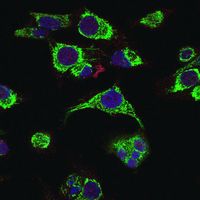Single-frequency lasers and ultrafast fiber lasers for Raman Spectroscopy
Providing chemical fingerprint to identify molecules
- Identify molecules using their chemical fingerprint
- Studying vibrational, rotational and other low-frequency modes
- Based on inelastic (Raman) scattering of monochromatic light
- Requires low-noise single-frequency lasers or ultrafast fiber lasers
Technique of Raman Spectroscopy
Raman spectroscopy is a technique used to study vibrational, rotational, and other low-frequency modes in a system. It is often used to provide a fingerprint that allows to identifiy molecules chemically. It is based on inelastic scattering (or Raman scattering) of monochromatic light. This light is usually generated using a laser with an output wavelength in the visible, near infrared, or near ultraviolet range.
The interaction between the laser light and molecular vibrations, phonons or other excitations in the system results in a frequency shift (up or down) of the laser light. This shift in laser frequency provides information about the vibrational modes in the studied system. Similar, but complementary information can be obtained using infrared spectroscopy.
In a typical setup, the sample is irradiated with the laser and the light is collected using a collecting lens subsequently, followed by a monochromator. Using a filter (notch filter, edge pass filter, or band pass filter) the elastically scattered radiation (Rayleigh scattering) at the wavelength that corresponds to the laser line is filtered out. The remaining collected light is dispersed onto a detector.
Raman scattering
Since spontaneous Raman scattering is typically very weak, the main difficulty of Raman spectroscopy is separating the weak inelastically scattered light (typ. 10-6) from the intense Rayleigh scattered light. Therefore, a strong suppression of the amplified spontaneous emission (ASE) in the utilized laser system is necessary. The combination of the small focus of a TEM00 laser beam with a microscope results in so-called micro Raman scattering.
For these techniques a wavelength of 532 nm is regularly used, as well as 785 nm (to reduce autofluorescence of the sample). For semiconductor inspection shorter wavelengths of 405 nm, 266 nm, or even 213 are commonly used.
Most recent, upcoming time-resolved Raman spectroscopy and microscopy application (i.e measurements on airplane engine exhausts to optimize the combustion process and reduce fuel consumption) trigger the need for pulsed laser sources operating in the femto- and picosecond regime. This demand is covered by the FemtoFiber laser family, which have already proven its outstanding performance and suitability in various broadband CARS and SRS applications

